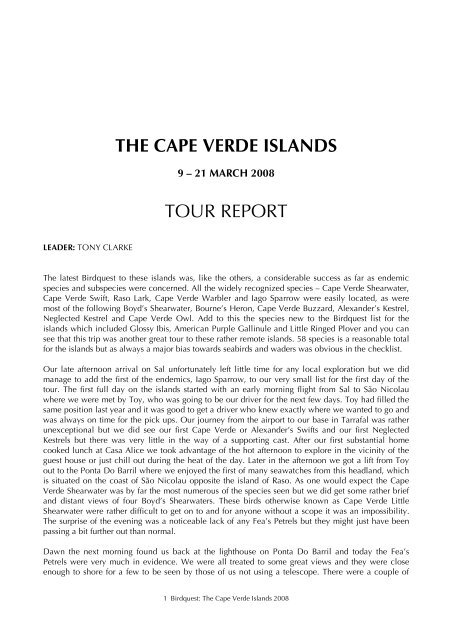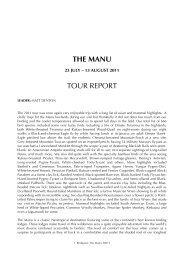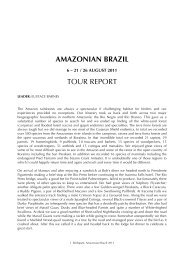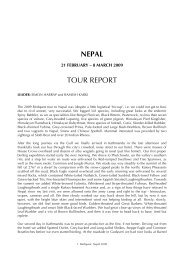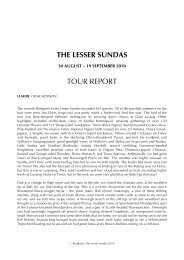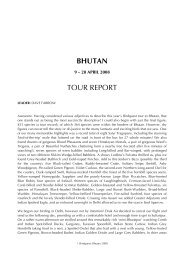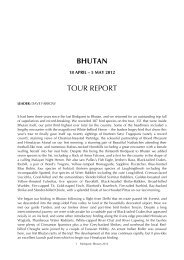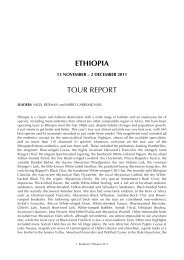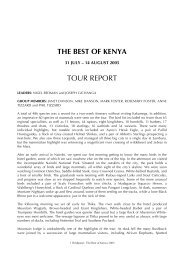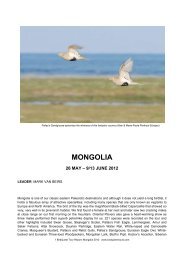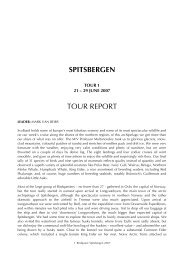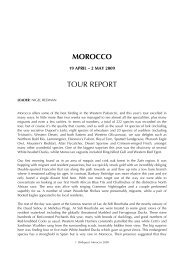THE CAPE VERDE ISLANDS TOUR REPORT - Birdquest
THE CAPE VERDE ISLANDS TOUR REPORT - Birdquest
THE CAPE VERDE ISLANDS TOUR REPORT - Birdquest
You also want an ePaper? Increase the reach of your titles
YUMPU automatically turns print PDFs into web optimized ePapers that Google loves.
LEADER: TONY CLARKE<br />
<strong>THE</strong> <strong>CAPE</strong> <strong>VERDE</strong> <strong>ISLANDS</strong><br />
9 – 21 MARCH 2008<br />
<strong>TOUR</strong> <strong>REPORT</strong><br />
The latest <strong>Birdquest</strong> to these islands was, like the others, a considerable success as far as endemic<br />
species and subspecies were concerned. All the widely recognized species – Cape Verde Shearwater,<br />
Cape Verde Swift, Raso Lark, Cape Verde Warbler and Iago Sparrow were easily located, as were<br />
most of the following Boyd’s Shearwater, Bourne’s Heron, Cape Verde Buzzard, Alexander’s Kestrel,<br />
Neglected Kestrel and Cape Verde Owl. Add to this the species new to the <strong>Birdquest</strong> list for the<br />
islands which included Glossy Ibis, American Purple Gallinule and Little Ringed Plover and you can<br />
see that this trip was another great tour to these rather remote islands. 58 species is a reasonable total<br />
for the islands but as always a major bias towards seabirds and waders was obvious in the checklist.<br />
Our late afternoon arrival on Sal unfortunately left little time for any local exploration but we did<br />
manage to add the first of the endemics, Iago Sparrow, to our very small list for the first day of the<br />
tour. The first full day on the islands started with an early morning flight from Sal to São Nicolau<br />
where we were met by Toy, who was going to be our driver for the next few days. Toy had filled the<br />
same position last year and it was good to get a driver who knew exactly where we wanted to go and<br />
was always on time for the pick ups. Our journey from the airport to our base in Tarrafal was rather<br />
unexceptional but we did see our first Cape Verde or Alexander’s Swifts and our first Neglected<br />
Kestrels but there was very little in the way of a supporting cast. After our first substantial home<br />
cooked lunch at Casa Alice we took advantage of the hot afternoon to explore in the vicinity of the<br />
guest house or just chill out during the heat of the day. Later in the afternoon we got a lift from Toy<br />
out to the Ponta Do Barril where we enjoyed the first of many seawatches from this headland, which<br />
is situated on the coast of São Nicolau opposite the island of Raso. As one would expect the Cape<br />
Verde Shearwater was by far the most numerous of the species seen but we did get some rather brief<br />
and distant views of four Boyd’s Shearwaters. These birds otherwise known as Cape Verde Little<br />
Shearwater were rather difficult to get on to and for anyone without a scope it was an impossibility.<br />
The surprise of the evening was a noticeable lack of any Fea’s Petrels but they might just have been<br />
passing a bit further out than normal.<br />
Dawn the next morning found us back at the lighthouse on Ponta Do Barril and today the Fea’s<br />
Petrels were very much in evidence. We were all treated to some great views and they were close<br />
enough to shore for a few to be seen by those of us not using a telescope. There were a couple of<br />
1 <strong>Birdquest</strong>: The Cape Verde Islands 2008
Boyd’s Shearwaters as well but these were rather distant and the views were rather brief but as always<br />
the Cape Verde Shearwaters kept us entertained throughout our vigil. After lunch we were taken up to<br />
the Monte Gordo Natural Park offices where we met Tali who explained about the setting up and<br />
running of the park as well as the problems with the government granting permits for Raso and<br />
Branco. This was a problem that was affecting us as much as anyone else even though our agents<br />
were trying their hardest to get the relevant permission before our planned trip to the islands. On our<br />
drive back to Tarrafal we encountered the first Helmeted Guineafowl of the trip, Toy was the first to<br />
spot them as they scurried up a hillside and away from the road. In the evening we did another<br />
seawatch but the species were much the same as the other seawatches and then it was back to Casa<br />
Alice for another fine and substantial evening meal.<br />
The following day was the day of reckoning but when the phone call came through the news was<br />
what we had been building ourselves up for. Unfortunately the government did not grant us the<br />
permission to land on Raso or Branco and so we would only be allowed to stay on the boat but<br />
would get as close as we could in our efforts to see the endemic Raso Lark. The crossing to Raso was<br />
a fairly calm one, and bird wise it was fairly flat as well because apart from the customary Cape<br />
Verde Shearwaters, all we saw were three Fea’s Petrels until we got close to the island. Then the<br />
shearwaters were replaced by Brown Boobies and Red-tailed Tropicbirds coming and going from<br />
their cliff colonies. The tropicbirds were one of the highlights of the tour as they went through their<br />
aerobatic courtship flights over our boat. Although the seabirds were excellent we had to think about<br />
how we were going to get the lark, which wasn’t going to be easy. We took the boat down to the<br />
south western end of Raso which is one of the best areas to see this bird if you can land on the island.<br />
Fortunately for us the conditions were favourable and after only a short wait we could see one bird as<br />
it occasionally performed its song flight. The views weren’t brilliant, in fact they weren’t even good,<br />
but we were able to observe the species from the boat which was better than it could have been. Also<br />
whilst sitting off shore we saw a couple of Ospreys, a Little Egret, a Eurasian Whimbrel, some Ruddy<br />
Turnstones, a Brown-necked Raven and a few distant Iago Sparrows which was basically what we<br />
would have seen if we were actually on the island. All in all we did very well considering we didn’t<br />
have any landing permission but it did mean that we couldn’t spend any time on Branco and so mid<br />
afternoon we returned to Tarrafal. After dinner we went out hunting for Cape Verde Barn Owl in the<br />
area around Praia Branca but we didn’t have much luck and after a couple of hours we returned to<br />
Casa Alice empty handed.<br />
We then had another day on São Nicolau because of the internal flight schedule and so we headed<br />
out to Ponta Do Barril for another seawatch which produced much of what we had been seeing on<br />
our other visits. Later in the morning the weather looked good inland and so we went up to the<br />
Monte Gordo Natural Park. Although this was not very productive on the avian front the botanical<br />
treasures were memorable with species like the numerous Euphorbia tuckeyana, the purple flowered<br />
Campanula jacobaea, the succulent Aeonium gorgoneum, the rather delicate Língua-de-vaca Echium<br />
stenosiphon and the yellow flowered Nauplius smithii. All of these plants are endemic to the Cape<br />
Verde Islands but they all have closely related species in the Canary Islands. After a late lunch and a<br />
lazy afternoon we went back to Ponta Do Barril for one last seawatch but we couldn’t locate anything<br />
different no matter how hard we tried.<br />
Our last full day on São Nicolau started with a boat trip out from Tarrafal to a few kilometres off<br />
Ponta Do Barril then parallel to the coast before returning to Tarrafal about mid day. We took a good<br />
supply of fish with us and from soon after leaving port we had a group of Cape Verde Shearwaters in<br />
permanent attendance that gave us some spectacular close up views. For the majority of our trip this<br />
was the only species we saw but a brief purple patch late on produced a couple of close Fea’s Petrels<br />
and the only Boyd’s Shearwater. This was one of the main target species for the trip as a couple of our<br />
group had not got on to any of the birds seen from the Ponta Do Barril during our various<br />
seawatching sessions. Fortunately this bird came close to the boat and was seen well by everyone<br />
even though it was just a brief encounter. The afternoon was spent at leisure but late on we went up<br />
2 <strong>Birdquest</strong>: The Cape Verde Islands 2008
to Cachaços and waited behind the church until it began to get dark. This was a beneficial exercise as<br />
just before it became totally dark a Cape Verde Barn Owl appeared from the cliffs and circled round<br />
in the direction of the nearby agricultural fields where it was presumably going to hunt for small<br />
rodents. A little earlier at the same location we were given some of our best views so far of Cape<br />
Verde Swifts and we could also hear their distinctive buzzing calls.<br />
The following morning we were on the move with the journey from Tarrafal to the airport and then<br />
after a minor delay we were on our way back to Sal. Unfortunately TACV seem to run virtually all<br />
their internal flights in and out of Sal further complicating the awkward inter island connections. This<br />
meant we had some time to kill before catching our onward flight to Boavista, some of this was taken<br />
up with a lunch stop in a local restaurant in Espargos but the rest of the time we used checking out<br />
the waders in the salt works. These are located at Pedra de Lume, which has already started to get<br />
developed for tourism around the coast. The salt works used to be a quiet and rarely visited location.<br />
This all changed a few years ago when it got opened up as the main tourist attraction on the island<br />
and nowadays the number of visitors may actually be effecting the number of waders wintering at this<br />
site. This year it was very noticeable that the number of birds at this location was much fewer than in<br />
previous years. The highlight of the visit was the Lesser Yellowlegs that had been present for some<br />
time but the other species recorded here included Black-winged Stilt, some nice summer plumaged<br />
Curlew Sandpipers, a Little Stint and a Grey Plover. After lunch in Espargos we were returned to the<br />
airport where we took our onward flight to Boavista. Upon arrival there was not much left of the day<br />
so a few people birded the coast close to the hotel, Tony had a meeting with Pedro Lopez to finalise<br />
the itinerary for the next 36 hours or so and a few just chilled out.<br />
After breakfast we were met at our hotel by Pedro and two 4x4 vehicles to take us to Curral Velho but<br />
the first stop was on the outskirts of Sal Rei where we saw our first Black-crowned Sparrow-larks, Bartailed<br />
Larks, a couple of Greater Hoopoe Larks and a Cream-coloured Courser. The journey down<br />
was otherwise uneventful and we duly arrived in the dunes at Curral Velho opposite the island where<br />
the frigatebirds nest. The Ilhéu de Curral Velho is a small rocky island about 500 metres offshore<br />
which plays host to a colony of Brown Boobies and the last remaining Magnificent Frigatebirds in the<br />
Western Palearctic. This year two females attempted to nest but only one laid eggs and these were<br />
infertile, which is the same situation as the last few years. After a rather nervous wait one of the<br />
females went for a short fly over the island which was fortunate for us because their nesting ledges<br />
are on the back of the island and the birds can not be seen from the shore. This is a spectacular<br />
species and it is a real pity to think that in the near future it will be extinct in the Cape Verde Islands.<br />
On the way back to Sal Rei we stopped a few times to watch a few Greater Hoopoe Larks and the<br />
occasional Cream-coloured Courser. We also called in briefly at the only fresh water site on Boavista,<br />
the small reservoir at Monte Trigo. On arrival we flushed a group of about 30 Helmeted Guineafowl<br />
but apart from these the only birds of note were a couple of Eurasian Spoonbills and a few of the<br />
more common species of waders. After lunch, back at the hotel, we made ready for a mid afternoon<br />
departure to Bahia das Gatas. En route we stopped at a village rubbish dump where Egyptian Vulture<br />
has been seen but unfortunately there were no birds at the site whilst we were in the area. Continuing<br />
on to Bahia das Gatas we got into our boat for the quick trip across to the Ilhéu dos Passaros which<br />
was only 600 or 700 metres from the mainland. The landing was a bit wet as the boat could not get<br />
onto the island because of a reef but although very slippery underfoot we all got ashore unscathed<br />
with our food and equipment still dry. Once on the island which is only about 200 metres in<br />
circumference Pedro had a marked path through to the centre of the island where we set up our<br />
camp for the night. Soon after dark we got our first views of our required target, the White-faced<br />
Storm-petrel. Soon it became very apparent that we were in for a great experience as we got more<br />
and more birds and better and better views. Seeing these birds and their ungainly behaviour once on<br />
the ground was one of the highlights of the tour for many of the group, even though getting on and off<br />
the island was a little wet and rather treacherous underfoot.<br />
3 <strong>Birdquest</strong>: The Cape Verde Islands 2008
After a rather sleepless night on Ilheu dos Passeros the boat arrived soon after 0700, but getting back<br />
on was probably slightly wetter than getting off the previous evening. However spirits were high and<br />
a little bit of sea water around the waist wasn’t going to dampen them much. Once off the island we<br />
went back to Sal Rei for breakfast and then to Rabil Lagoon for a quick look around. Once at the site,<br />
we realized the water level was well down on previous years which is worrying, and we heard that<br />
the huge construction projects nearby were just taking the water they needed from the lagoon as it<br />
was a ‘free’ source. Ecological problems aside, the lagoon was still attractive to waterbirds and there<br />
were a reasonable selection of waders, the best of which were a couple of Ruffs and a Lesser<br />
Yellowlegs. In the afternoon we took a flight over to Santiago but there was a delay of just over an<br />
hour which for TACV is actually quite good but meant that our arrival at our hotel was somewhat<br />
later than anticipated. They were waiting for us but the food took a while to prepare and it was rather<br />
late by the time we retired for the night.<br />
Our first port of call on Santiago was the heavily vegetated valley around Boa Entrada. This is usually<br />
an excellent site for the endemic Cape Verde Warbler but this morning things didn’t seem to work<br />
out. All we managed with the warbler were a few distant calls and a very brief sighting by one<br />
observer. Perhaps the increased activity in the valley may have effected the population but the<br />
vegetation seems the same so perhaps it was just a bad day. The local populations of Grey-headed<br />
Kingfisher and Common Waxbill do seem to have maintained their status in the area and we got<br />
some excellent views of both these species. From here we moved on to the botanic gardens at São<br />
Jorge dos Orgãos where we stopped for our lunch but within minutes of our arrival we had located a<br />
pair of very vocal and showy Cape Verde Warblers that were also very photogenic. Also whilst at the<br />
same location Tommy and Ilona saw a distant Cape Verde Buzzard which fortunately put in a repeat<br />
appearance and was seen by all of us, but it was still rather distant. After consuming the rest of a<br />
rather interrupted picnic we made our way to the Barragem de Poilão which is the best freshwater<br />
site on Santiago. Although the site was still good the water level had dropped dramatically since last<br />
year and the site may not be functional for birdwatchers within the next three years or so. Doom and<br />
gloom aside the site is still good and we recorded a good selection of species here including the<br />
highly prized Bourne’s Heron. This rare endemic is now known to have a pair breeding at a new<br />
location inside the Serra Malagueta Natural Park but the main breeding site is still the tree in Liberão<br />
which as the crow flies is just a short distance from the reservoir. We also saw Glossy Ibis and Little<br />
Ringed Plover at this site which were new species for the <strong>Birdquest</strong> Cape Verde list, a fine subadult<br />
American Purple Gallinule which was the first record for the islands, a Lesser Yellowlegs and the<br />
third Little Bittern for Cape Verde, but we had known about all of these birds in advance and didn’t<br />
discover anything new ourselves. Less unusual species here included Eurasian Spoonbill, Common<br />
Snipe, Common Greenshank and Green and Wood Sandpipers.<br />
On the penultimate day of our trip, we returned to the Barragem de Poilão, but the birds were much<br />
the same as yesterday, and we could not locate the previously reported Intermediate Egret even<br />
though we waited for a couple of hours or more just in case it decided to drop in. We then went<br />
round to Liberão for our picnic which we took by the Bourne’s Heron nesting tree, but as expected<br />
the birds that were seen earlier in the month had departed, and the tree was empty apart from the old<br />
nests. After a short while we continued along the minor road which although rather scenic produced<br />
no birds of note, but a few nice views. We then returned to São Jorge dos Orgãos where the Cape<br />
Verde Warblers entertained us again before we returned to Tarrafal. In the evening, prior to dinner,<br />
we went out to the abandoned sewage ponds to try for a Cape Verde Barn Owl but none appeared<br />
and we had to go back to the hotel with just three Black-crowned Sparrow-larks for our trouble.<br />
In the morning of our last day we tried the coastal lagoons at Pedra Badejo but after an hour and a<br />
half to get there it was disappointing to find that this was another site that had deteriorated. Water<br />
levels were very low and there were no birds present at all, at least we verified that this location need<br />
not be visited in the future. We took lunch back at Tarrafal where we were entertained by a few low<br />
level Cape Verde Swifts, the ever present Grey-headed Kingfishers and some of the more common<br />
4 <strong>Birdquest</strong>: The Cape Verde Islands 2008
species and then all too soon it was time to make a move towards Praia. We had an evening meal in<br />
one of the restaurants in the capital near to the bustling market area at Sucupira, which gave us one<br />
final encounter with the colourful local people. After dinner Daniel drove us the short distance to the<br />
airport where we sat around for the rest of the evening before catching the flight back to Lisbon in the<br />
early hours of the morning.<br />
5 <strong>Birdquest</strong>: The Cape Verde Islands 2008
SYSTEMATIC LIST<br />
Species which were not personally recorded by the leader are indicated by the symbol (NL).<br />
PROCELLARIIDAE<br />
Fea’s Petrel (Cape Verde P) Pterodroma feae: Only seen from Ponta do Barril, where it was a bit<br />
distant, from the crossings to and from Raso and from our minor pelagic when some of<br />
the views were excellent but rather short lived.<br />
Cape Verde Shearwater Calonectris edwardsii: Common from Ponta do Barril, numerous on the<br />
crossings to and from Raso and on our impromptu pelagic.<br />
Boyd’s Shearwater (Cape Verde Little S) Puffinus boydi: A few distant birds were seen from Ponta do<br />
Barril (but not as many as last year) and one was seen well but briefly from the pelagic<br />
trip.<br />
HYDROBARIDAE<br />
White-faced Storm-petrel Pelagodroma marina: As we were unable to spend the night on Branco this<br />
year the Ilhéu dos Passeros was a previously unused backup for our trip. It was<br />
excellent, the birds just kept coming and although it would be difficult to estimate the<br />
numbers of birds seen because of repeated sightings of the same individuals we guessed<br />
that a minimum of twenty birds were involved.<br />
PHAETHONTIDAE<br />
Red-billed Tropicbird Phaethon aethereus: Seen on Boavista but the experience of sitting off Raso,<br />
under the cliffs where they breed, and watching the birds go about their daily business<br />
was one of the highlights of the trip.<br />
SULIDAE<br />
Brown Booby Sula leucogaster: Seen on São Nicolau, Raso and Boavista. The best views were from<br />
the boat looking the colony on Raso but the largest concentration was the colony on<br />
Ilhéu do Curral Velho off Boavista.<br />
FREGATIDAE<br />
Magnificent Frigatebird Fregata magnificens: As is usual nowadays our only sightings of this species<br />
were from Curral Velho on Boavista. We didn’t manage a male but thanks to the<br />
assistance of Pedro Lopes, the local guide, we got some great looks at one of the<br />
females.<br />
ARDEIDAE<br />
Little Bittern Ixobrychus minutes: Only the third record for the Cape Verde Islands. This bird was<br />
seen on both our visits to the Barragem de Poilão on the 18 th and 19 th .<br />
Western Cattle Egret Bubulcus ibis: Common on all the main islands visited with the exception of<br />
São Nicolau where it was rather scarce.<br />
Little Egret Egretta garzetta: Most numerous at the Barragem de Poilão on Santiago.<br />
Grey Heron Ardea cinerea: Widespread but not common anywhere.<br />
Bourne’s Heron (Cape Verde Purple H) Ardea bournei: The breeding tree at Liberão had been<br />
deserted a few days before our visit but fortunately we saw two immature birds on the<br />
nearby Barragem de Poilão.<br />
THRESKIORNITHIDAE<br />
Glossy Ibis Plegadis falcinellus: An adult was seen at the Barragem de Poilão on Santiago during both<br />
our visits to this site on the 18 th and 19 th . It was only the forth record for the islands and<br />
a first for the <strong>Birdquest</strong> list.<br />
6 <strong>Birdquest</strong>: The Cape Verde Islands 2008
Eurasian Spoonbill Platalea leucorodia: Two were on the small fresh water site on Boavista, Monte de<br />
Trigo, and then seven birds were at the Barragem de Poilão, Santiago, on both our visits.<br />
Two of these birds were ringed in the Netherlands as nestlings on 26 June 2006 and<br />
were present at the same location in late March last year.<br />
ACCIPITRIDAE<br />
Cape Verde Buzzard Buteo bannermani: Two were seen around São Jorge dos Orgãos on the 18 th .<br />
Unfortunately neither were seen as well as we would have liked but nowadays any<br />
Cape Verde Buzzard is a pleasing site as these birds seem to getting more scarce.<br />
PANDIONIDAE<br />
Osprey Pandion haliaetus: Only small numbers recorded from São Nicolau, Raso, and Boavista.<br />
FALCONIDAE<br />
Alexander’s Kestrel Falco alexandri: Easily seen on Sal, Santiago and Boavista where it is a common<br />
resident.<br />
Neglected Kestrel Falco neglectus: Quite common on São Nicolau. This is the more distinctive of the<br />
two being smaller and more Merlin-like in flight.<br />
PHASIANIDAE<br />
Common Quail Coturnix coturnix: Only one was seen this year on the headland close to Tarrafal,<br />
Santiago, on the final morning of the tour.<br />
NUMIDIDAE<br />
Helmeted Guineafowl Numida meleagris: This year birds were seen on São Nicolau and a large<br />
group at the Monte de Trigo site on Boavista. It was a bit of a surprise that we saw none<br />
around the Barragem de Poilão this year but then again the increased local population<br />
have to eat something along with their crops.<br />
RALLIDAE<br />
American Purple Gallinule Porphyrio martinica: One, a subadult, was seen on both our visits to the<br />
Barragem de Poilão on Santiago. This species was a new bird to the Cape Verde Islands<br />
and therefore an automatic addition to the <strong>Birdquest</strong> list for the islands. It had been seen<br />
earlier by other groups so we could not be credited with the find.<br />
Common Moorhen Gallinula chloropus: About ten birds were seen on our visits to the Barragem de<br />
Poilão which included both adults and well grown young indicating that the species<br />
had bred here recently. This species would appear to have started breeding regularly at<br />
this location.<br />
RECURVIROSTRIDAE<br />
Black-winged Stilt Himantopus himantopus: Seen at Pedra de Lume (Sal), Monte Trigo and Rabil<br />
Lagoon (Boavista) and at the Barragem de Poilão (Santiago). The highest concentration<br />
this year was at Rabil Lagoon on Boavista.<br />
GLAREOLIDAE<br />
Cream-coloured Courser Cursorius cursor: Even scarcer than last year with a mere half a dozen<br />
getting seen on Boavista. Birds were seen on the outskirts of Sal Rei, the drive to Curral<br />
Velho and the return drive from Bahia das Gatas.<br />
CHARADRIIDAE<br />
Little Ringed Plover Charadrius dubius: Four were seen at the Barragem de Poilão, on Santiago, a<br />
new addition to the <strong>Birdquest</strong> list.<br />
7 <strong>Birdquest</strong>: The Cape Verde Islands 2008
Common Ringed Plover Charadrius hiaticula: Nowhere common this year with records from Pedra<br />
de Lume on Sal and from Monte Trigo and Rabil Lagoon on Boavista.<br />
Kentish Plover (Snowy P) Charadrius alexandrinus: Perhaps the numbers of visiting tourists is having<br />
an effect on the numbers of waders at Pedra de Lume on Sal, because this year this<br />
species was most numerous at Rabil Lagoon on Boavista.<br />
Grey Plover (Black-bellied P) Pluvialis squatarola: This year only recorded from Sal and Boavista with<br />
the largest count of four from Rabil Lagoon.<br />
SCOLOPACIDAE<br />
Sanderling Calidris alba: Seen in small numbers on São Nicolau and Sal but this year it was most<br />
numerous at Rabil Lagoon on Boavista.<br />
Little Stint Calidris minuta: One at Pedra de Lume on Sal and four at Rabil Lagoon on Boavista were<br />
the only records this year.<br />
Curlew Sandpiper Calidris ferruginea: Another species with a decline in numbers at Pedra de Lume<br />
on Sal with only about 30 present this year whereas there were about 80 at Rabil<br />
Lagoon on Boavista.<br />
Ruff Philomachus pugnax: Two were seen at Rabil Lagoon on Boavista on the 17 th .<br />
Common Snipe Gallinago gallinago: One at Rabil Lagoon on Boavista and then a maximum of five at<br />
the Barragem de Poilão on Santiago. This species seems to be becoming more common<br />
in the islands.<br />
Eurasian Whimbrel Numenius phaeopus: One of the most widespread of the shorebirds recorded<br />
with records from most of the islands visited.<br />
Common Redshank Tringa totanus: Two at Pedra de Lume on Sal on the 15 th and then one at Rabil<br />
Lagoon on Boavista on the 17 th .<br />
Common Greenshank Tringa nebularia: This species was recorded on Sal, Boavista and Santiago<br />
with a maximum of seven birds at the Barragem de Poilão on the 19 th .<br />
Lesser Yellowlegs Tringa favipes: One at Pedra de Lume on Sal on the 15 th and another at the<br />
Barragem de Poilão, Santiago, on the 18 th and 19 th .<br />
Green Sandpiper Tringa ochropus: A maximum of two birds at the Barragem de Poilão, Santiago on<br />
the 19 th .<br />
Wood Sandpiper Tringa glareola: Two at the Barragem de Poilão on both our visits to the site.<br />
Common Sandpiper Actitis hypoleucos: Quite a widespread species but nowhere common with a<br />
maximum of four at the Barragem de Poilão on the 19 th .<br />
Ruddy Turnstone Arenaria interpres: This was the most numerous and widespread of all the<br />
shorebirds recorded.<br />
COLUMBIDAE<br />
Rock Dove Columba livia: Common and widespread but genuine looking birds are getting harder to<br />
find among the Feral Pigeons.<br />
TYTONIDAE<br />
Cape Verde Owl (CV Barn O) Tyto detorta: One was seen at Cachaços on the evening of the 14 th<br />
which was seen well by everyone who went to look. The bird appeared just before dark<br />
when it flew off the cliff and circled around to hunt over the fields near the village. Then<br />
on the 17 th two were seen by Tony on the drive from the airport at Praia to Tarrafal on<br />
Santiago.<br />
APODIDAE<br />
Cape Verde Swift Apus alexandri: Seen on both Santiago and São Nicolau but our best views were<br />
those seen flying around our hotel at Tarrafal on the 19 th .<br />
8 <strong>Birdquest</strong>: The Cape Verde Islands 2008
ALCEDINIDAE<br />
Grey-headed Kingfisher Halcyon leucocephala: Common and very conspicuous on Santiago and as<br />
always this was a popular bird with the group.<br />
ALAUDIDAE<br />
Black-crowned Sparrow-lark (B-c Finch-lark) Eremopterix nigriceps: These birds were a common<br />
feature on Boavista but we also saw a couple in the vicinity of the abandoned sewage<br />
farm near Tarrafal on Santiago.<br />
Bar-tailed Lark (B-t Desert L) Ammomanes cincturus: Recorded on both Sal and Boavista but it was<br />
much more numerous on the latter.<br />
Greater Hoopoe Lark Alaemon alaudipes: Only recorded on Boavista where it was common and<br />
widespread on our journeys to and from Curral Velho and Bahia das Gatas.<br />
Raso Lark (Razo L) Alauda razae: This year because of the problems created for us by the Cape<br />
Verdean government we could only sit off Raso and wait patiently. Rather surprisingly<br />
this tactic paid off and we managed to see one bird song flighting over the southwestern<br />
part of the island.<br />
HIRUNDINIDAE<br />
Barn Swallow Hirundo rustica: Two were seen at Tarrafal, São Nicolau, on the 10 th and then four<br />
were seen on the 15 th on the same island.<br />
House Martin Delichon urbica: One was seen on São Nicolau on the 11 th and was a non-leader<br />
record, however the same or another was seen on the 14 th .<br />
SYLVIIDAE<br />
Cape Verde Warbler (CV Cane W) Acrocephalus brevipennis: This year rather unusually this species<br />
was only recorded from São Jorge dos Orgãos on Santiago. Despite some thorough<br />
searching we could not get to grips with any in the Boa Entrada valley apart from one<br />
heard briefly and distantly and one glimpsed by one or two of the group.<br />
Spectacled Warbler Sylvia conspicillata: Common and widespread on Santiago, São Nicolau and<br />
Boavista.<br />
Blackcap Sylvia atricapilla: Fairly common on all the main islands visited with the exception of Sal.<br />
CORVIDAE<br />
Brown-necked Raven Corvus ruficollis: Recorded from all the main islands visited.<br />
PASSERIDAE<br />
Spanish Sparrow Passer hispaniolensis: Fairly common on both Santiago and Boavista.<br />
Iago Sparrow Passer iagoensis: The most common and widespread of the Cape Verde endemics.<br />
ESTRILDIDAE<br />
Common Waxbill Estrilda astrild: Common and widespread on Santiago where we recorded it in<br />
fairly large numbers by the hotel in Tarrafal, in Boa Entrada and by the access road to<br />
the Barragem de Poilão.<br />
9 <strong>Birdquest</strong>: The Cape Verde Islands 2008


